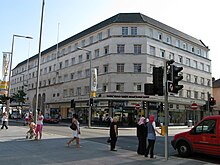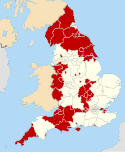|
Leicester City Council
Leicester City Council is the local authority for the city of Leicester, in the ceremonial county of Leicestershire, England. Leicester has had a council from medieval times, which has been reformed on numerous occasions. Since 1997 the council has been a unitary authority, being a district council which also performs the functions of a county council; it is independent from Leicestershire County Council. The council consists of 54 councillors, overseen by a directly elected mayor. The council also appoints a ceremonial Lord Mayor who chairs council meetings; the directly elected mayor is termed the City Mayor to distinguish the post from the Lord Mayor. The council has been under Labour majority control since 2007, and the City Mayor has been Sir Peter Soulsby since 2011. The council meets at Leicester Town Hall and has its main offices at City Hall on Charles Street. HistoryThe council traces its roots to the Corporation of Leicester, and before then to the Merchant Gild and the Portmanmoot. The Portmanmoot consisted of 24 Jurats, elected from the burgesses (members of the Gild Merchant, or freemen), along with two bailiffs, and a clerk. It appears to have existed before the Norman Conquest in 1066. In 1209, the lead member of the Portmanmoot, the Alderman, became known as a mayor. The Gild Merchant and the Moot overlapped in membership and had probably become effectively merged in the 14th century. Membership of the Twenty-Four appears to have been by co-option, chosen by themselves. Traditionally, the general populace attended some meetings of the Moot and Guild, but this was restricted to burgesses in 1467. Later, in 1489, this changed to a system where the Mayor and the Twenty-Four chose Forty-Eight burgesses to represent the others, and the Twenty-Four and the Forty-Eight would govern jointly. After doubts as to the ability of the Moot and Gild to hold property arose in the 16th century, the corporation was formed, replacing the Gild and Portmanmoot, in 1589. A second charter was granted in 1599, reconfirming this, to The Mayor, Bailiffs and Burgesses of the Borough of Leicester. The 24 Jurats became known as the Aldermen of the corporation, and the 48 other Burgesses as the Common Council. The members of the Corporation chose the burgesses to send to the House of Commons. Leicester was reformed to become a municipal borough in 1836 under the Municipal Corporations Act 1835, which standardised how most boroughs across the country were governed. The borough was then led by a corporate body formally called the "mayor, aldermen and burgesses of the borough of Leicester", which was generally known as the corporation or town council.[4] The previous system of co-option for members of the council was replaced with elections by rate-payers. This led to a prolonged spell of Liberal control of the council. When elected county councils were established in 1889, Leicester was considered large enough to provide its own county-level services, and so it became a county borough, independent from Leicestershire County Council.[5] In 1919 Leicester was awarded city status, after which the corporation was formally called the "mayor, aldermen and citizens of the city of Leicester", also known as the city council. In 1928 the council was given the right to appoint a Lord Mayor.[6] The corporation was replaced in 1974 under the Local Government Act 1972, with the modern Leicester City Council, a non-metropolitan district council. This was a lower tier district-level authority, with county-level services being provided to the city by Leicestershire County Council for the first time. In 1997, Leicester City Council regained responsibility for county-level services from Leicestershire County Council as part of the 1990s UK local government reforms. The way this change was implemented was to create a new non-metropolitan county of Leicester covering the same area as the existing district, but with no separate county council; instead the existing city council took on county functions, making it a unitary authority. This therefore had the effect of restoring the city council to the powers it had held when Leicester was a county borough prior to 1974.[7] In 2011, following a referendum, the position of directly elected mayor was created to provide political leadership for the council. The directly elected mayor is called the City Mayor to distinguish the post from the continuing position of Lord Mayor. The Lord Mayor acts as a ceremonial figurehead for the city and chairs council meetings, with the position usually being held by a different councillor each year. GovernanceAs a unitary authority, Leicester City Council provides both county-level and district-level services. Some services are provided via joint committees with other councils, notably the Leicestershire Fire and Rescue Service and Leicestershire Constabulary, which are run by joint boards of the city council with Leicestershire County Council and Rutland County Council. There are no civil parishes in the city.[8] Political controlThe council has been under Labour majority control since 2007. Political control of the council since the 1974 reforms took effect has been as follows:[9] [10] Non-metropolitan district
Unitary authority
LeadershipPolitical leadership is provided by the directly elected Mayor of Leicester. The separate post of Lord Mayor is the council's ceremonial figurehead and chairs full council meetings. Prior to 2011 political leadership was provided by the leader of the council. The leaders from 1974 to 2011 were:[11]
Since 2011, the directly elected mayor has been:
CompositionFollowing the 2023 election, and subsequent changes of allegiance up to July 2024, the composition of the council, excluding the City Mayor's seat, was:[13][14]
The next election is due in 2027. Premises The council has its main offices at City Hall on Charles Street, which was built in 1938, previously being called Municipal Buildings and Attenborough House until it was renamed City Hall in 2014.[15] Council meetings are held at Leicester Town Hall on Town Hall Square, which was completed in 1876.[16] Between 1975 and 2014 the council had its main offices at the New Walk Centre, which has since been demolished.  ElectionsSince the last boundary changes in 2015 the council has comprised 54 councillors representing 21 wards with each ward electing two or three councillors. Elections are held every four years, with the election for the mayor and council being held together.[17] The wards are:[18]
A new set of wards and ward boundaries came into effect for the 7 May 2015 council elections. Wards that previously existed and were abolished are Charnwood, Coleman, Freeman, Latimer, New Parks and Western Park. The previous ward boundaries were adopted for the 2003 local elections.[19] Prior to this, there had been 28 wards, each electing 2 members. Wards that had existed and been abolished were Crown Hills, East Knighton, Mowmacre, North Braunstone, Rowley Fields, Saffron, St Augustine's, West Humberstone, West Knighton and Wycliffe. Coat of arms
References
External links |
|||||||||||||||||||||||||||||||||||||||||||||||||||||||||||||||||||||||||||||||||||||||||||||||||||||||||||||||||||||||||||||||||||||||||||||||||||||||||||||||||||||||||||||||||||||||||||||||||||||||||||||||||||||||||||||||||||||||||||





